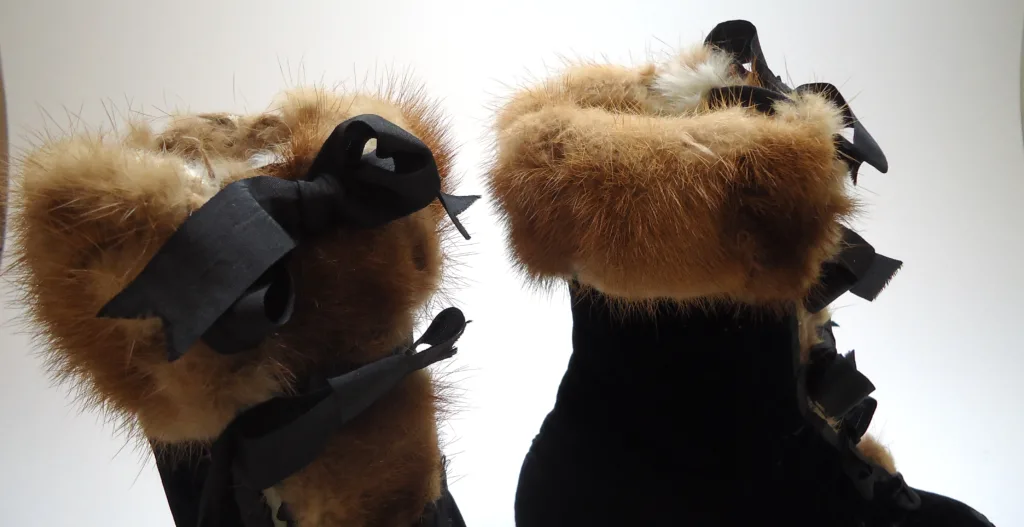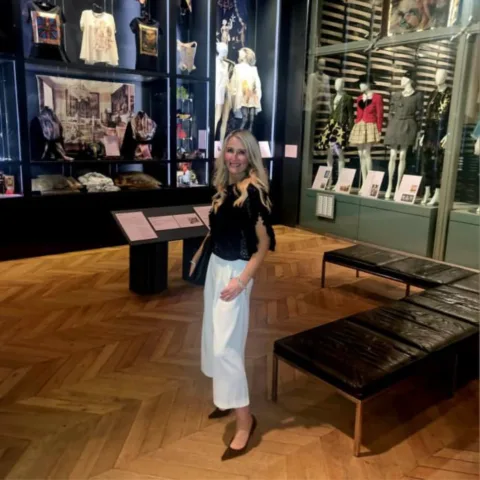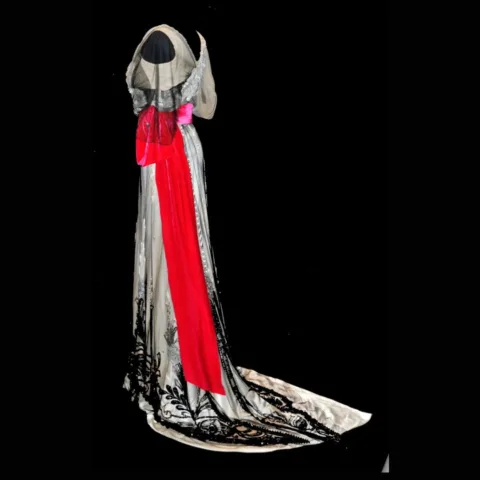The Bowes Museum Blog

Fit For An Empress: The Conservation of Eugenie’s Carriage Boots

For this extended blog post, I will discuss the conservation of a pair of 19th century velvet carriage boots [CST.140], which have been lent to the Victoria & Albert Museum, and their forthcoming exhibition on shoes.
The boots had been on display in The Bowes Museum’s Fashion & Textile Gallery for the past 4 years. However, they required conservation to make them fit to travel to London, and beyond, as they will then form part of the exhibition’s international tour. The loan request provided an opportunity to remove and replace areas of previous repair, and conserve the areas of damage.
The boots came to the Bowes Museum in 1954, donated as part of a larger collection of Napoleonic costume and accessories, by Miss Alice Edleston, who lived in nearby Gainford. They had been purchased at an auction of Eugenie’s costume and effects, following her death at Farnborough in 1920. Alice’s brother published several books on the subject of Napoleon III, and amassed his own collection of Napoleonic memorabilia, including military uniforms and hats, which also formed part of the Edleston bequest to the Museum.
The Bowes Museum is fortunate to have several pairs of Eugenie’s shoes, including a pair of ice skates, which are on permanent display in the Fashion & Textile Gallery. There are also a number of bodices, which would have been worn with the large cage crinolines which Eugenie made famous. She patronized Charles Worth in Paris, where a silk and silver embroidered paletot jacket (recently returned from a loan to the Design Museum), with matching bodice, is thought to have been purchased. The 1924 estate sale of Eugenie’s clothes, furs, and accessories dispersed her possessions far and wide. Prior to her death, she funded St. Michael’s Abbey in Farnborough, where she was subsequently buried, alongside Napoleon III. In her later years, she donated items of her clothing to the abbey, including her wedding dress, to be made into ecclesiastical vestments.Carriage boots were designed to protect the feet during cold carriage rides. This pair, dating to around 1870, are made of navy velvet, fully lined with long white rabbit fur, and trimmed with a coarser brown fur, thought to be mink. The edges are bound in black silk grosgrain ribbon, and the shape of the heel is commonly known as the ‘Louis’. The boots fasten at the front with 4 black silk ribbon bows, and have only suffered light wear during their use. The condition of the boots has been rated as ‘fair’, considering their age, use, and materials. The silk ribbons were heavily creased (having been tied in very tight bows), with numerous splits and tears. Most of the ribbons had at some point torn from the boots, and been crudely stitched back in place with thick black thread. Where the silk ribbons had torn completely across their width, the raw ends had been overlapped, and roughly stitched back together. The old repairs were both visually distracting, and were poorly executed.
Any conservation treatment begins with a thorough examination of the object, and documentation of its current condition. The conservation of the silk ribbons was planned, the bows were to be carefully undone, the ribbons flattened to remove creases, and support patches applied. All old repairs would be removed, and replaced, so that they would be less visible, and the ribbons would be properly supported. Rather than tying the fragile silk back into bows, they were to be folded into a suggested bow shape, with a new piece of black silk fabric introduced to hold them together.
Untying the bows, and humidifying the ribbons allowed the full extent of their damage to be seen for the first time. There were more old repairs than previously thought, with most of the ribbons having torn loose from the boots and been re-attached in a rather haphazard manner. The repair stitching was too tight, in a thick thread, causing crushing and distortion.
The process of humidifying the silk ribbons involved the slow and gentle introduction of moisture, in the form of water vapour. Damp blotting paper was placed beneath a piece of Sympatex (a semi-permeable membrane), and the ribbon laid over the top. Sandwiched with a piece of polythene to create a micro-climate, the ribbons were left to slowly humidify, before the creases were eased out, and the ribbons weight with glass to dry flat. The process was repeated several times, until the ribbons were flat, straight, and all distortions removed. The old repairs were left in situ for the time-being, to be removed and replaced one at a time so as not to mix up the many short lengths of ribbon.
The next stage of the conservation process was to prepare the support fabric. A black silk crepeline was selected, the colour matched exactly to the ribbons, it would visually disappear, while providing the support required to bridge the splits and tears, and without adding any extra bulk to the ribbons. An adhesive technique was to be used, whereby a thin adhesive film is cast onto the textile and allowed to dry, before the patches are cut to size, and the adhesive re-activated in situ, with minimal supplementary conservation stitching.

A makeshift humidity chamber, with ultrasonic humidifier to provide the cool steam, and Hanwell monitor to observe the changes in relative humidity
The adhesive selected was a mixture of Lasxaux 360 HV and Lascaux 498 HV, both dispersions of a thermoplastic acrylic polymer, and the technique is a common one for the conservation of fragile textiles which require minimal stitching. Using a piece of polythene sheeting, stretched taught on the work surface as a casting bed, the silk crepeline was dampened and laid out, ensuring that the grain was perfectly straight. A humidity chamber was built over the area to raise the relative humidity (which normally hovers around 30% in the studio), bringing it up to 55-60%. A 10% solution of the adhesive was made up, using a 1:2 ratio of the 498 HV: 360 HV. Using a foam roller, it was then applied to the crepeline, ensuring an even coat. The adhesive was then left to dry slowly (the humidity chamber ensures that it does not dry too quickly).
The polythene could then be cut free from the work surface. Before applying to the object, tests were carried out on a piece of silk of a similar weight. A heat-reactivation method was chosen, using a heated spatula, set to 60 degrees C. Small pieces of the adhesive film were cut, the polythene backing removed, and the crepeline was laid down onto the silk, aligning the grain, and using finger heat and pressure to secure in place. With a piece of silicone-release paper as a barrier, the heated spatula was used to re-activate the adhesive for several seconds. A glass weight was then applied over the area, and it was left to cool entirely. A peel strength test was carried out, pulling one corner of the crepeline free to test it’s resistance. The silk was also manipulated in different directions to ensure that the crepeline would not come loose from the surface with handling.
Each ribbon was repaired systematically, using small patches extending across the full width of the ribbon, and roughly 1.5cm either side of any tear. Old repairs were removed, patches added, and supplementary stitching carried out. The edges of the patches were secured, and as an extra precaution against repeated handling, a small amount of stitching was carried out, in a perpendicular direction, across the worst of the tears.
Where the ribbons had been roughly re-attached to the boots, the old repair threads were removed, and ends of the ribbons flattened. The ends were badly damaged from being folded over, and stitched too tightly. Where necessary, they were encased in silk crepeline, before being re-attached to the boot.
With the conservation of the ribbons complete, the next step was to recreate the bows down the front of each boot. Tying them back into tight bows would cause further damage, as they would have to be twisted, and pulled, which would cause further splitting, distortion, and was not ideal for their long-term care.
Slipping a piece of Melinex behind the ribbons to hold the fur out of the way, each ribbon was folded once, with the two lengths crossed over each other into a simple bow shape, and held in place with an entymological pin. I had calculated which way each ribbon would be folded, to ensure that all of the silk crepeline patches were on the reverse sides of the ribbon. This meant that as the ribbons are laid out flat, they have patches on either side, but once folded into ‘bows’, none of the patches are visible.
A new piece of black silk Habutai, medium-weight, to match the silk of the ribbons was cut into strips. With the raw edges turned inward, the new silk was looped around the silk ribbons, and stitched in place loosely.
Using blunt-nosed curved tweezers, and a very steady hand, the excess silk fabric was then rolled backward, pulling the stitch line to the reverse, and tightening the loop. The area where the ribbons cross is now curved backwards, but not creased or crushed. The new piece of silk was then stitched in place, tight enough to hold the ribbons and stop them from escaping, but not tight enough to cause any damage.
Shoes: Pleasure & Pain, is on at the Victoria & Albert Museum, London, from 13th June 2015, until the 31st January 2016.
By Katy Smith, Textile Conservator
























